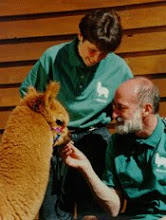
I have been halter training the juvenile alpacas. We are late in doing this. Usually I have them trained at weaning, which is around six months of age. These guys are all ten, eleven or twelve months old. Moving to Montana and then back to Arizona meant a lot of things got delayed this year!
But the youngsters are coming along beautifully. I had a helper today - someone who had never trained an animal before. Of course, I had to train my helper first, before we could train the babies. While explaining the process I realized that the best advice I ever got for training alpacas came from a Special Ed teacher. She said that working with special ed kids requires you to think really hard about all the steps in the process of whatever skill you are trying to teach. "Chunk it down" is how she phrased it. It is a perfect motto for training animals.
We tend to think of outcomes. What do I want this animal to do? I want it to walk on a lead. So we grab the alpaca, shove a halter on its head, snap on a lead rope and off we go. Typically all hell breaks loose at this point, and we can't figure out what went wrong.
What went wrong is that we need to think of baby steps instead of the ultimate outcome. Even something as simple as walking on a lead comes from learning to do many smaller things. Some of the steps include:
-learning to have a human handler in close proximity without running away
-learning to stand quietly while restrained by an arm around the neck
-learning not to pull away when the halter is being put over the nose
-learning that the halter noseband will not cut off breathing (if it is positioned correctly, that is)
-learning to stand quietly when the headband latch is fastened
-learning to accept the feel of the halter on the head
-learning to accept the feel of the added weight of the lead rope snap hanging from the halter
-learning to accept the long 'snakey' looking lead rope
-learning that a tug on the lead rope, which creates pressure behind the alpaca's ears, means to move forward
-learning to keep moving forward until the handler stops
-learning that a tug to the side means to turn to that side
-learning to walk in unfamiliar areas with the handler, past scary things such as gates, vehicles, cats, wind-blown weeds, etc.
-learning to stop and stand when the handler stops
-learning not to race past the handler when spooked
-learning to allow the handler to approach and touch the alpaca
-learning to allow the handler to remove the halter without pulling away
Whew! That is a lengthy list for the most basic of alpaca training projects. It is always amazing to me how quickly the alpacas learn all this. I never teach lessons longer than 15 to 20 minutes, and in about three lessons I can have any alpaca walking pretty well on the lead. Give me another three lessons and they will look like they were born wearing a halter and walking on the lead.
These animals are really smart and learn fast. They will learn what you want them to learn, or they will learn something less helpful. It's all in how well you teach.



No comments:
Post a Comment